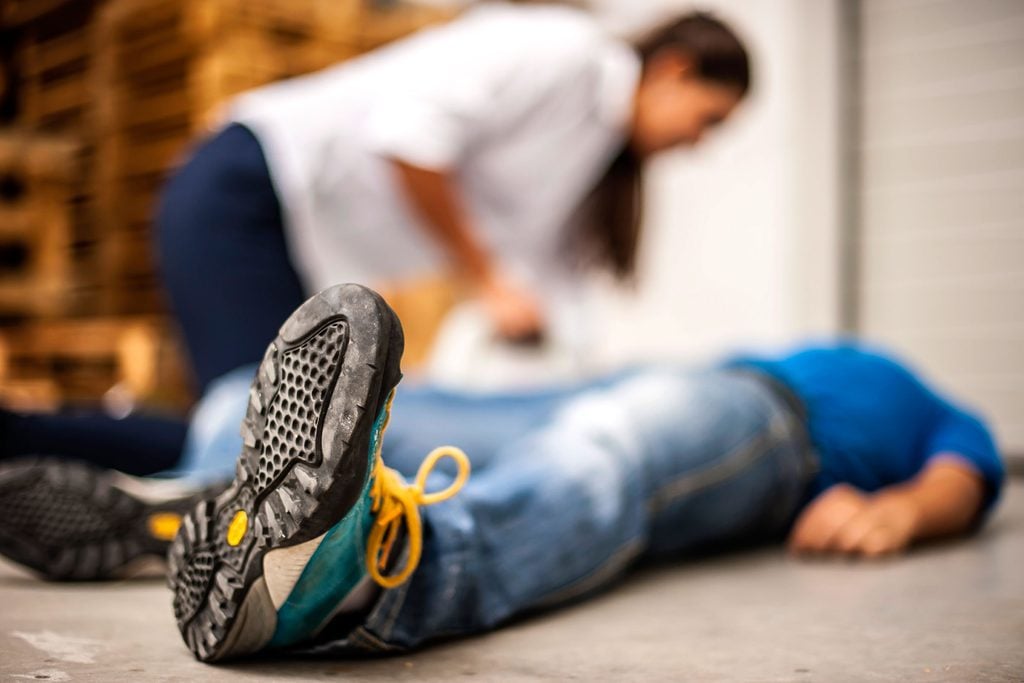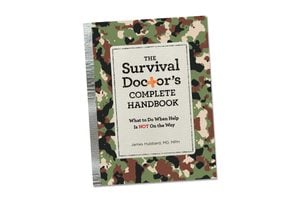The Scientific Reason Why Healthy People Faint—and How to Treat Them
Updated: Feb. 24, 2021

Know the best way to respond when someone faints and the signs that indicate they should seek further treatment.
Our editors and experts handpick every product we feature. We may earn a commission from your purchases.
James Hubbard, MD, is a family doctor and author of The Survival Doctor’s Complete Handbook.
It happens to the best of us
Fainting—the medical term is “syncope”—is a sudden and temporary loss of consciousness caused by lack of adequate blood flow to the brain. That’s different from getting knocked out or losing consciousness from, say, a drug overdose or an insulin coma. Here are some common signs you’re about to faint.
True story: in my first year of medical school, we were all standing in a lab room and were told to partner up and prick each other’s fingers with a sterile lancet. I heard a crash across the room. One of my classmates had fainted. By the time I saw what was going on, he was getting up. He finished the test, and last I heard, he was a successful surgeon.
Over the years, I’ve instituted a rule: no matter how tough someone with an injury appears, I have him or her sit or lie down. And anyone who’s with the injured person must sit down also. Many people faint if they remain standing, especially if there’s blood and they try to watch the treatment procedure.
Types of fainting
Before learning what to do for someone who’s fainted, it’s helpful to learn some of the reasons for fainting. In a survival situation, you may not always know the reason for fainting, but you can at least be aware of some causes and what you can and can’t do about them.
Vasovagal syncope: when healthy people faint
Vasovagal syncope, which involves the vagus nerve, is the most common type of fainting. Fright, pain, anxiety, and fast breathing can bring this kind of fainting on. Sometimes the trigger can be the sight of blood; sometimes it’s coughing; urinating; straining, as with a bowel movement or lifting something heavy; or even laughing. It’s why my medical classmate passed out and it can happen to perfectly healthy people. (Speaking of that, this is the one health screening you need regardless of how healthy you are.)
The vagus nerve starts in the brain stem and works its way down the side of the neck and into the chest and abdomen. One of its jobs is to help regulate your blood pressure. Vasovagal syncope happens when your vagus nerve reacts to a situation by suddenly lowering your blood pressure (through decreasing your heart rate, relaxing your arteries, or both). This results in a sudden lack of blood to the brain. The vasovagal reaction can also cause certain symptoms to precede the fainting, such as increased respiration, sweating, nausea, and a faster heartbeat. Why a particular situation will trigger that sort of reaction in some people and not others is poorly understood. It’s also called reflex or situational syncope.
Postural syncope: standing up and falling down
When you stand, your body has to react in a way that ensures that blood flow continues to the brain. For this, it needs a strong heart that’s beating well, blood vessels that constrict when they’re supposed to, and enough blood cells and fluid in the arteries. If the adjustment process takes longer than usual, a type of fainting called postural syncope may occur.
Blood loss, severe anemia, and dehydration can cause postural syncope. Also, standing in one spot too long can pool so much blood in the legs that the heart temporarily lacks an adequate supply to pump to the brain. These are signs you might be dehydrated.

Fainting treatment
No matter the cause of fainting, if someone suddenly appears sweaty or has a vacant look in her eyes, suggest she sit down and bend over so her head is lower than her chest. If she’s willing, lying down is even better. If she starts to fall, try helping her down so she won’t get hurt. (Don’t hurt yourself in the process.) Never keep her upright, because this may continue to keep blood from getting to the brain.
Once the head is as low as or lower than the heart, the victim should regain consciousness, albeit probably in a groggy state. Have her stay in that position for several minutes until the fainting symptoms subside. Check the pulse and blood pressure if you have a cuff. Make sure they’re normal before she tries to get up. Then she can sit for a few minutes, and if there are no symptoms, she could slowly try to stand.
If the fainting symptoms recur, help her lower herself again, let the symptoms subside, and slowly try once more. If the person is able to sit up for a few minutes and eventually stand, the cause is likely vasovagal, especially if you can pinpoint a trigger, such as a fright or the sight of blood. If you’re not sure it’s vasovagal, call 911 if possible. Meanwhile, try to get a quick medical history and physical evaluation.
Fainting red flags to watch out for
Often, the likely reason for the fainting is pretty obvious, like if the person has lost a lot of blood or is dehydrated from vomiting. Other times, a little detective work is required. Here are some of the red flags that indicate that something serious is going on and that expert treatment, if available, is a must:
1. No warning signs before fainting, fainting while sitting or lying down, or heart palpitations that last more than a few seconds before the victim passes out: This means the heart could be to blame and needs immediate evaluation.
2. Passing out while exercising: Although this may turn out to be vasovagal and not serious, it can also be the only sign of an otherwise asymptomatic heart problem, which would increase the risk of sudden death with exercise in the future
3. Pupils that are unequal in size: this means there could be serious pressure on the brain from a stroke, trauma, or a tumor. Don’t ignore these stroke symptoms.
4. A severe headache: this could indicate a migraine or stroke.
5. Double vision, which could mean stroke, migraine, or brain tumor. Here are some more signs of a brain tumor that you should be aware of.
6. Strange symptoms before fainting, such as seeing, smelling, touching, or hearing something funny; feeling numbness or tingling; or twitching. Or, during the episode, urinating or defecating; stiffening or shaking, especially on one side of the body. These are signs of a seizure, and you need medical evaluation.
7. Excruciating back or abdominal pain, which could be a sign of a dissecting aortic aneurysm, a condition in which the wall of the aorta—the blood vessel connected straight from the heart—starts tearing apart. Immediate transfer to a hospital could mean the difference between life and death. Here are some more important medical facts that doctors say could save your life.
 The Survival Doctor’s Complete Handbook will take you step by step through the essentials of medical care during an emergency. Maybe you live alone in a rural area, or you just want to make sure you and your family are prepared to safely weather the next natural disaster. Whatever your situation and your health needs, The Survival Doctor’s Complete Handbook is your must-have medical resource.
The Survival Doctor’s Complete Handbook will take you step by step through the essentials of medical care during an emergency. Maybe you live alone in a rural area, or you just want to make sure you and your family are prepared to safely weather the next natural disaster. Whatever your situation and your health needs, The Survival Doctor’s Complete Handbook is your must-have medical resource.

